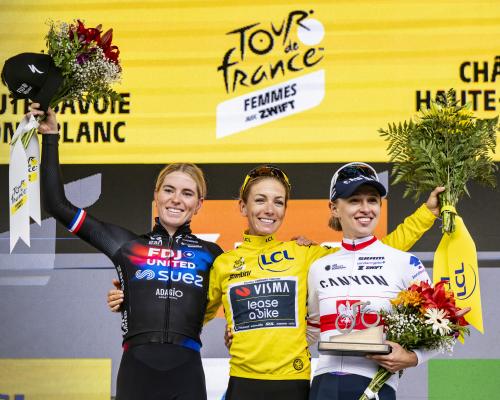
It took a long time to find a copy of L’Equipe on Monday morning. France’s flagship daily sports newspaper, emblazoned with an image of a yellow-clad Pauline Ferrand-Prévot, arms outstretched and triumphant, with the banner headline Geante, had almost sold out.
Ferrand-Prévot, the first French rider to win the Tour de France Femmes, has become a national icon almost overnight. After her Paris 2024 gold-medal performance in mountain biking and this spring’s win in Paris-Roubaix, Ferrand-Prévot fever has taken over. Cycling’s slumbering giant has finally awoken.
As a little girl, Ferrand-Prévot asked her mother why it was that she couldn’t race in the Tour de France. “But it’s a men’s race,” came the response. “I wish I was a boy,” the nine-year-old Pauline said.
The French have waited a long time to see one of their own in the yellow jersey – 36 years in women’s racing and 40 in men’s – and endured decades of humiliation plus an ingrained sense of inferiority, usually to multiple foreign champions, some of them doped.
During that time, there have been other misfiring women’s tours of France, but none of them compare with the significance and scale of the modern Tour de France Femmes, which Christian Prudhomme, race director of the men’s Tour and initially sceptical of the women’s race, now sees as equal in stature.
For archivists, the last French rider in yellow was Jeannie Longo, who won the Tour de France Féminin in 1989, although that race did not compare with the investment, difficulty and global importance of the modern Tour Femmes.
Justifiably, Ferrand-Prévot has been depicted as the successor to Bernard Hinault, the last French winner of the men’s Tour. The celebratory televised phone call from President Macron, within minutes of her victory in Chatel, is evidence of that.
Ferrand-Prévot’s Olympic gold came while she was sponsored by Ineos Grenadiers, but their reluctance to invest further in women’s racing led to her off-season move to the Visma Lease-a-bike team, and a vow to win the Tour within three years. Jim Ratcliffe’s loss has become the Dutch sponsor’s gain.
For the French, this was equivalent to England men’s long-awaited home Ashes win in 2005, or Andy Murray’s breakthrough British Wimbledon victory in 2013. The 33-year-old may well have uncorked fresh ambition within the host nation, and not just in women’s racing.
Compare Tadej Pogacar’s muted celebrations after winning his fourth Tour de France a week ago in Paris with the party vibe in Chatel late on Sunday evening and the differences between the men’s and women’s Tour are far greater than just of gender.
In stark contrast, there is an openness, joy and freedom of expression to the Tour de France Femmes that puts the monastic and secretive world of its occasionally lumbering male counterpart to shame.
Ferrand-Prévot came to the Tour Femmes parchment thin, compared to the rider who powered to victory over the cobbles of Paris-Roubaix in April. The dramatic weight loss enhanced her power to weight ratio, but it doesn’t look good and she has readily acknowledged it.
“I don’t want to stay like this, because I know it’s not 100% healthy,” she said on Sunday evening, “but we also had a good plan with the nutritionist in the team and everything is in control.
“I didn’t do anything extreme, and I still had power left after nine days of racing. It’s a tricky subject, because you have to find the limit. I also know that I can’t stay like this forever. It’s the choice I made.”
The already lean Demi Vollering, second overall in Chatel, an athlete who has openly talked about teenage mental health and menstrual cycles, also faced questions on whether she would now seek to lose weight to become more competitive.
“I could lose weight too, but I don’t want to be extremely thin,” she said. “I’m proud of my weight and want to set a good example. I hope that in the future I can win again and show girls that you don’t have to be super skinny, but that you can also win with hard work and power.
“I know that many others struggle with this, so I hope that young girls don’t think they have to be super skinny to ride in the mountains.”
Kasia Niewiadoma, the outgoing champion, highlighted the fast-track development in ability within the women’s peloton and said that her own level was “definitely higher” than that of a year ago.
“This is the growth of women’s cycling,” Niewiadoma said after finishing third. “I think that the teams are stronger. You can see that a lot of teams have grown in depth – they have really strong riders who can help their leaders.”
Of course, the Tour Femmes is not perfect. As the pressure to perform grows along with the rewards, it will inevitably develop some of the same ethical issues that confront men’s racing. But, right now, it is refreshing, joyous, dramatic and exciting, with a growing roster of accomplished athletes.
“Watch The Femmes” say the caps tossed to the crowds from the publicity caravan. “We don’t need the men any more to exist,” said the race director Marion Rousse earlier this summer after announcing the move to stand-alone dates for the Femmes in 2026. Rousse is right. Maybe we have been watching the wrong race all along.



